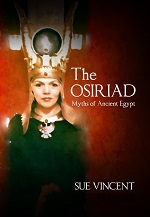
Repton today is no more than a small Derbyshire village, but once it was the capital of Mercia, one of the most powerful realms of its era. For three hundred years, Mercia encompassed most of what would eventually become the England that we know today. Repton, as its capital, was at the heart of the land and knew many of the people and events that shaped our country, including the last pagan king and the official acceptance of Christianity.
When Paeda sought to wed the Princess Alchflaed, daughter of King Oswiu of Northumbria, it was a condition of the marriage that he should adopt the Christian faith. His father, King Penda, was the last pagan king of Mercia, who was later killed in battle by the same Oswiu in 655AD. Penda accepted but did not adopt the new religion himself, though he lived and fought alongside Christians and allowed the introduction of Christianity to his realm in 653 when some of the royal family were baptised in Repton.

Christianity came to Repton with Alchflaed and the four monks who accompanied her from Lindisfarne… the same Holy Island we had so recently visited. An Abbey was founded in 660AD as a double monastery for both men and women in the tradition of the Ionian church. Its first Abbess was St Werburgh, whose path had crossed our own many times and most noticeably at Chester. The first church at Repton dates to this time… and left some curious relics. Some of these we would eventually see. For others, we could only look at the history of the area…
In 1686, a labourer named Thomas Walker who had been looking for stone near the church, left an account of strange doings in Repton. He found two underground rooms, at the centre of which was a stone coffin containing the bones of a man nine feet tall. Around it, he said, were the bones of a hundred other people, all with their feet pointing towards the coffin.

In 1727, years after he found the grave, he told this story to a traveller who left this account:
“about 40 years since, cutting hillocks near the surface, he met with an old stone wall. When clearing it further, he found it to be a square enclosure of 15ft. In this he found a stone coffin, and saw in it the skeleton of a human body 9ft long, and round it one hundred skeletons of the ordinary size, laid with the feet pointing to the stone coffin. The head of the great skeleton he gave to Mr Bowes, master of Repton School. I enquired at this school and one of the present masters (who is the son of Mr Bowes) concerning the skull but it is lost; yet he says, he remembers the skull in his father’s closet, and that he often heard his father mention this gigantic corpse, and thinks that the skull was in proportion to a body of that stature. The present owner will not suffer it opened, the lady of the manor having forbidden it.”
Nine feet tall? Walker was not believed, in spite of having removed the skull, and it took another two hundred and fifty years before a sceptical archaeologist took a perfunctory look… and it was not until the 1980s that any serious work was done.
The bones of at least two hundred and sixty four people were found. The bones had been defleshed, cleaned and stacked and appear to have been part of a royal Mercian burial, that had been reused by the Viking invaders around 873.

Given the known history of the Vikings in the area, it seems likely that the central burial was that of Ivar the Boneless, known as a cruel and vicious leader. (A full and detailed account of this discovery, with pictures, can be found on the Church website HERE).
The warrior had been buried with the bones of his men… probably dug up to be re-interred with him. There was evidence of pagan rites and possible human sacrifice… no wonder the village is said to be haunted!
We hadn’t even got inside the church and we had already walked through a couple of thousand years of really unusual history… and while I had been to the church before and had an idea of what we might find, we had no idea whether or not we would see what we had come to see…










































So cool!
LikeLike
It is 🙂
LikeLike
This is so interesting, Sue. Thanks for sharing. 🙂 — Suzanne
LikeLike
It is an amazing find.
LikeLike
What a cliff hanger to leave us on, Sue! 🙂
LikeLike
Sorry about that 😉
LikeLike
This town has some ghoulish history! Lead on!
LikeLike
Yet it holds such beauty too 🙂
LikeLike
Fascinating!
LikeLike
🙂
LikeLike
Wow. Amazing that someone would take the skull of a 9 ft skeleton, kept it in his closet, and then lose it. My husband and I watch the fictional “Vikings” show, and it’s so interesting to see the real places where it all occurred. The Church article is fascinating as well.
LikeLike
Hi Diana…for some reason, I only just got notified of this comment!
It really does seem odd, doesn’t it, and yet, there are a good few similar tales we have encountered over the years…
LikeLiked by 1 person
I haven’t been online at all, Sue, so no worries. I’m going to post a story for your prompt in the morning. I have another busy month with my parents, but I’m slowly easing back into blogging and can’t wait. 🙂
LikeLike
Hope all us well, Diana. You’ve been missed x
LikeLiked by 1 person
Interesting because removal of the skull would potentially fit with dark Age beliefs about head worship
LikeLike
There would be a link, yes.
LikeLiked by 1 person
A most interesting post, Sue. I must have missed this when you posted it originally.
LikeLike
Under the circumstances, I thought you might fid it interesting, Robbie.
LikeLike
Pingback: Guest author: Roberta Eaton Cheadle – The Vikings in York: Ivar the Boneless – Roberta Writes